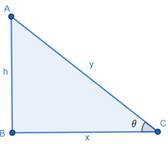If the sum of the lengths of the hypotenuse and a side of a right angled triangle is given, show that the area of the triangle is maximum when the angle between them is  .
.
Given: a right-angled triangle, such that sum of the lengths of its hypotenuse and side is given
To show: the area of the triangle is maximum when the angle between them is ![]()
Explanation:

Let ΔABC be the right-angled triangle,
Let hypotenuse, AC = y,
side, BC = x, AB = h
Now sum of the side and hypotenuse is given,
⇒ x+y = k, where k is any constant value
⇒ y = k-x………..(i)
Now let A be the area of the triangle, then we know
![]()
Now applying the Pythagoras theorem, we get
y2 = x2+h2
![]()
Now substituting equation (i) in above equation, we get
![]()
![]()
![]()
Now substituting the value from equation (iii) into equation (ii), we get
![]()
Now differentiating above equation with respect to x, we get

Now taking out the constant term we get

Now applying the product rule, we get


Applying the power rule of differentiation on second part in above equation, we get




![]()
Now critical point is found by equating the first derivative to 0, i.e.,
![]()
![]()
![]()
![]()
![]()
⇒k2-2kx = kx
⇒k2 = 2kx+kx
⇒ k2 = 3kx
⇒ k = 3x
![]()
Again, differentiating equation (iv) with respect to x, we get

Taking out the constant term and taking the LCM, we get



Applying the product rule of differentiation, we get

Now applying the power rule of differentiation, we get




Substituting ![]() , in above equation, we get
, in above equation, we get






Hence the maximum value of A is at ![]()
We know,
![]()
Now from figure,
![]()
Substituting the value of y = k-x from equation (i), we get
![]()
Substituting the value of ![]() , we get
, we get


![]()
This is possible only when ![]()
Hence the area of the triangle is maximum only when the angle between them is ![]()